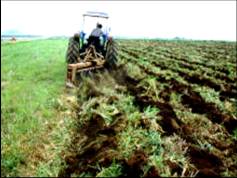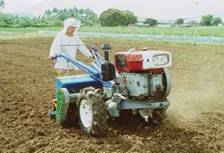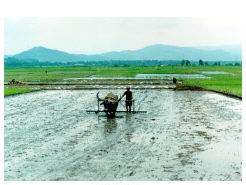|
|
|
Water management |
|
||||||||
|
|
|
|
|
||||||||
|
|
|
Minimizing water use during land preparation |
|
||||||||
|
|
|
|
|
||||||||
|
|
|
Describe how to minimize water use for land preparation |
|
||||||||
|
|
|
How is the land prepared?
Land preparation is a field operation to make the rice field ready for planting. It normally consists of a series of plowing (1 to 2 times), harrowing and leveling (2 to 3 times) of the field to make it suitable for crop establishment.
This plowing, harrowing and leveling can be done either with a dry field (non-puddled) or a wet field (puddled).
In both wet and dry land preparation, it is important to properly level the field to promote and maintain a uniform water depth and thus ensure good crop stand and increase water use efficiency.
|
|
||||||||
|
|
|
So how do we minimize water use for land preparation?
1. By shifting from puddled to non-puddled Large amounts of water (20-40% of the total water use) are consumed during the wet (or puddled) land preparation because of the need to initially soak to soften a dry and cracked soil and to keep the field continuously flooded during the land preparation period. Most of the water consumed in this field operation is lost by percolation and seepage. On the other hand, dry (non-puddled) land preparation does not require a large amount of irrigation water during this field operation because this field operation can be done when the soil has the correct moisture and is friable for plowing or rotovating and harrowing.
2. Reducing the duration of land preparation and synchronous operations 37% of the total water consumed in irrigated production systems is consumed for wet or puddled land preparation. (see lesson 1 of this module) One of the major reasons for this high consumption is the long duration of land preparation (around 40 days in most systems). In order to reduce the water consumption, prepare the land as fast as possible.
3. Reducing by-pass flow through cracks by shallow tillage High water loss during land preparation for rice production results from bypass flow through cracks. Shallow tillage uses an average of 31 - 34% less water for land soaking and preparation compared with regular tillage. Shallow tillage forms small soil aggregates, which block and impede water flow in the cracks and reduces the amount of water that recharges the groundwater. Water saving during the land preparation may increase the service area of an irrigation system. |
|
||||||||
Next lesson |
|
The last lesson of this module explains at which growth stages water is important. |
|
||||||||






